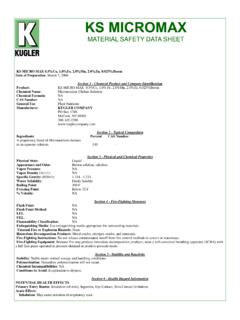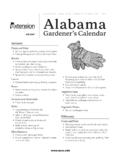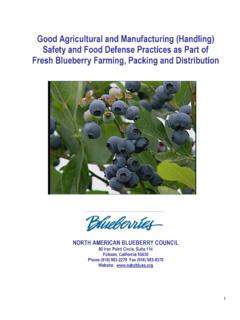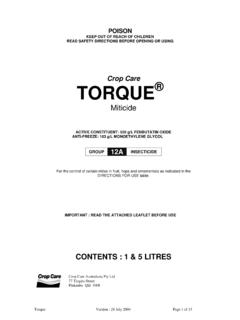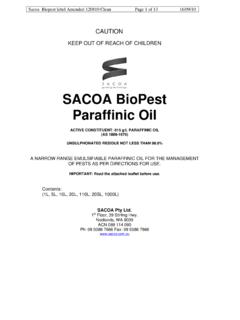Transcription of KQ-XRN - Kugler Company
1 CABBAGE, CAULIFLOWER, BROCCOLI: 2-3 gals/acre at early head formation and repeat 7-10 days later. CELERY: 1-2 gals/acre 10 days after transplanting. Repeat at 2 gals/acre in 3 intervals until 3 weeks prior to harvest, using 7-8 gallons total over crop. CITRUS: 1-5 gals/acre at pre-bloom or bloom to increase fruit set and repeat in 30 days. Subsequent applications when nitrogen needs are evident CORN: May apply up to 5 gals/acre with seed at planting. Foliar apply up to 2 gals/acre any time extra nitrogen is needed. CORN (SEED): May apply up to 5 gals/acre with seed at planting. Foliar apply 2 gals/acre before detasseling and repeat after pollination. COTTON: Early Season: 1-2 quarts/acre in an over the row application after plants reach 4 leaf stage. Mid-Season: 2-5 gals/acre at early bloom and repeat as necessary.
2 CUCUMBERS, SQUASH, PUMPKINS, WATERMELONS, CANTALOUPES: 1-3 gals/acre at early bloom and repeat approximately 4 weeks after bloom application. GARLIC: Spray 1-2 gals/acre directed over row from 10-12 inches high. Make 3-4 applications. GRAPES (TABLE): 1-2 gals/acre when nitrogen needs are evident or an increase in canopy is required to reduce sunburn. GRAPES (SEED PRODUCTION): 1-1 gals/acre at pre-bloom. 2-3 gals/acre at seed head elongation. LETTUCE: 2-3 after thinning. Repeat 14 days later and again 14 days prior to harvest. MILO and OTHER SORGHUMS: May apply up to 3 gals/acre with seed at planting. Foliar apply up to 2 gals/acre at any time extra nutrition is needed. MINT (PEPPERMENT, SPEARMINT): For row or establish mint: 2-3 gals/acre end of March, early April 3-5 gals/acre post flame late April, early May.
3 May be combined with fungicide. 2-3 gals/acre mid June. Combine with pesticide 3-5 gals/acre mid July. Combine with pesticide 2-3 gals/acre Post Harvest. Can be combined with other nutrients. Can be combined with crop protection chemicals when properly buffered. KQ-XRN pH is Apply in sufficient water, minimum of 20 gals/acre to provide good coverage to foliage. ONIONS: 2 gals/acre when onions reach 6-8 inches repeat during bulb fill, and again in two weeks prior to harvest. PEACHES, PLUMS, PRUNES, NECTARINES, APRICOTS: 1 1 gals/acre at bud swell to early bloom when increase fruit set is desired and repeat in 30 days to maintain increased set. Apply 2-4 gals/acre 4-6 priors to harvest for improved fruit sizing, firmness and reduction in green shoulders . Rate dependent upon tree size and conditions. Post Harvest: apply 5-10 gals/acre in 1 or 2 applications.
4 PEANUTS: 3-5 gals/acre at early bloom and repeat as necessary until pods are filled. PEARS (BARTLETT): 1 1 gals/acre at pre-bloom and repeat every 30 days until 4 weeks prior to harvest. As some varieties ( , D Anjou) are more sensitive under certain conditions, extreme caution should be exercised. Post Harvest: Apply 5-10 gals/acre in 1 or 2 applications. PEPPERS: 2-3 gals/acre at early bloom and repeat 14 days later GUARANTEED ANALYSIS: Total Nitrogen (N)*..28% Urea Nitrogen Slowly available water soluble nitrogen* derived from urea, polymethylene urea, methylene diurea and monomethylol urea. Slowly available water soluble nitrogen* from urea, polymethylene urea, methylene diurea and monomethylol urea. Weight per lbs. Gallons per Nitrogen per lbs. MANUFACTURED BY Kugler Company 209 West 3rd; PO Box 1748 McCook, NE 69001 308 -345 -2280 CAUTION: KEEP OUT OF REACH OF CHILDREN.
5 Do not get in eyes, on skin or on clothing. Wear goggles, face shield, or safety glasses and rubber gloves when handling. If eye exposure occurs get medical attention immediately. Harmful if swallowed. Avoid breathing vapor. Protect from freezing. Read entire label before using. Wash contaminated clothing before reuse. WHAT TO DO IN CASE OF CONTACT: IF IN EYES: Flush eyes with water for 15 minutes, holding eyelids open. Obtain medical attention if irritation develops. IF ON SKIN: Wash skin thoroughly with soap and water. Get medical attention if irritation develops. IF SWALLOWED: Drink large volumes of water and induce vomiting by placing finger at back of throat. Call a physician or poison control center. IF INHALED: Move to fresh air. Obtain medical attention if irritation develops.
6 If contact is made with spray solution containing pesticide(s), follow the "Statement of Practical Treatment/First Aid" the pesticide(s) label. GENERAL INFORMATION: Foliar fertilization is intended as a supplement to a regular fertilization program and will not, by itself, provide all the nutrients normally required by most crops. 72% of the total Nitrogen in this product is controlled release. RECOMMENDED FOLIAR RATES: ALFALFA: 1-2 gals/acre. Apply after each cutting when sufficient foliage is present. May be used with pesticides. APPLES: 1-1 gals/acre in bud swell to king bloom and 1-1 gallons 30 days later. 1-1 gals/acre 30-40 days prior to harvest for sizing. Post harvest: Apply 3-5 gals/acre in 1 or 2 applications. SNAP BEANS: 3 Gals/acre at early bloom (with fungicide). Can be applied in split applications DRY BEANS: 2-3 gals/acre at early bloom.
7 And repeat after pods are formed. GREEN BEANS & PEAS: 1-3 Gals/acre shortly after first flowers appear and repeat 10-14 days later. LIMA BEANS: 2-3 gals/acre at early bloom and repeat after pod fill begins. KQ-XRN 28-0-0 with 72% Slow Release Nitrogen TECH SHEET RECOMMENDED DRIP FERTIGATION RATES: strawberries : 3-4 gals/acre twice a month for five to six months in California. TOMATOES/PEPPERS: 3-5 gals/acre twice a month for three to four months. GRAPES: 3-5 gals/acre twice a month for three to four months LETTUCE: 3-5 gals/acre at first irrigation and repeat as needed. TREES & VINES: 5 gals/acre at least every 30 days in sandy soils. Apply in combination with other drip materials at 25 and 50% ratios to improve fertilizer efficiency. to improve fruit set and canopy and reduce sunburn. POTATOES: 2 gals/acre prior to tuberization and at early bloom at 2 gals/acre.
8 A third application of 2 gals/acre 2-3 weeks following bloom spray may be needed through fertigation system. Can be applied in pesticides. Buffering of combinations may be necessary as KQ-XRN is pH stable at SEED CROPS: 1 -2 gals/acre at early bloom. 3-4 weeks later apply 2 gals/acre. 30-60 days prior to harvest apply 2 gals/acre to fill out seed. SOYBEANS: 2-3 gals/acre at early pod. Apply 1-2 gals/acre anytime with your glyphosate. SPINACH: 2-3 gals/acre when adequate foliage. Apply again 7-10 days prior to harvest if double cropping. strawberries : 1-3 gals/acre when early bloom and repeat in 14-21 days. SWEET CORN: 2-3 gals/acre at a 12-14 inch height, at early tassel stage, and again at early silk stage. TOMATOES: 2-3 gals/acre at early bloom. Repeat at fruit set and again 15-30 days later. Apply 3-4 gals/acre.
9 3-4 weeks prior to harvest to strengthen canopy and to reduce sunburn. WHEAT: 2-5 gals/acre at flag leaf stage depending on residual soil fertilizer or rainfall, etc. Flag leaf stage according to Feekes Scale is generally the sixth or seventh true leaf on the main stem of the plant. Can be applied with herbicides at 1-2 gals/acre. Can also be applied with Tilt in low volume or undiluted. TURF AND ORNAMENTAL RECOMMENDATIONS; BENT GRASS: lbs of nitrogen per 1000 sq. ft. per year applied in multiple applications of 1/8 lb of nitrogen. Use higher rates in areas with prolonged growing season, areas of high use or grow in situations. BERMUDA GRASS: lbs of nitrogen per 1,000 sq. ft. per year in multiple applications of - lb nitrogen. Use higher rates in areas with prolonged growing season, areas of high use or grow in situations.
10 BLUE GRASS & OTHER COOL SEASON GRASSES: lbs. of nitrogen per 1,000 sq. ft. per year in multiple applications. Use higher rates in areas with prolonged growing season, areas of high use or grow in situations. ST. AUGUSTINE & OTHER WARM SEASON GRASSES: lbs. of nitrogen per 1,000 sq. ft. per year in multiple applications. Use higher rates in areas with prolonged growing season, areas of high use or grow in situations. ORNAMENTAL & CONTAINER GROWN PLANT MATERIAL: Fertigation: Apply to 2 gallons per acre through the irrigation system or soil drench. Repeat as necessary to maintain optimal plant growth and vigor. Check with local or state agency for anti-siphon requirements. Foliar Application: Use to 1 gallon per 100 gallons of water per application dependent upon crop requirements. TREE & SHRUB: 1 to 3 lbs.
